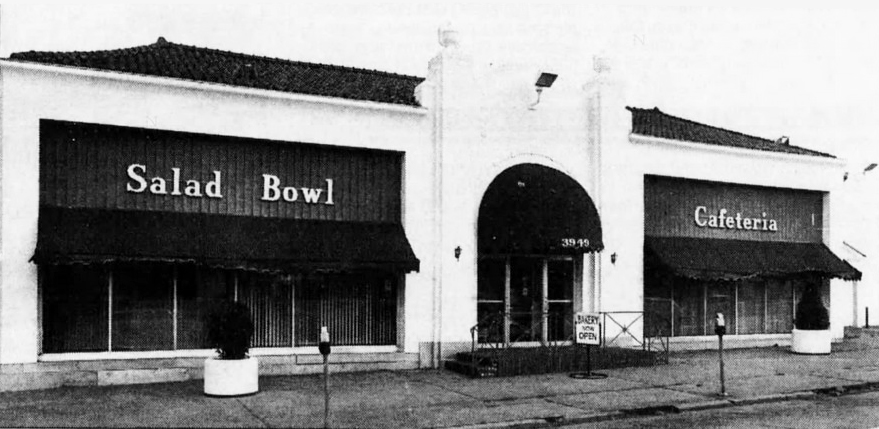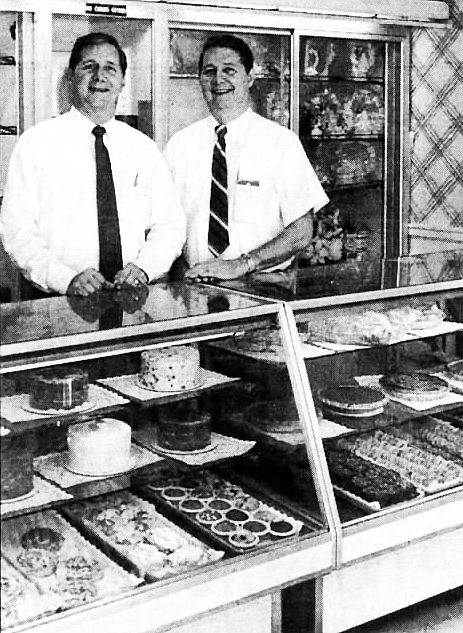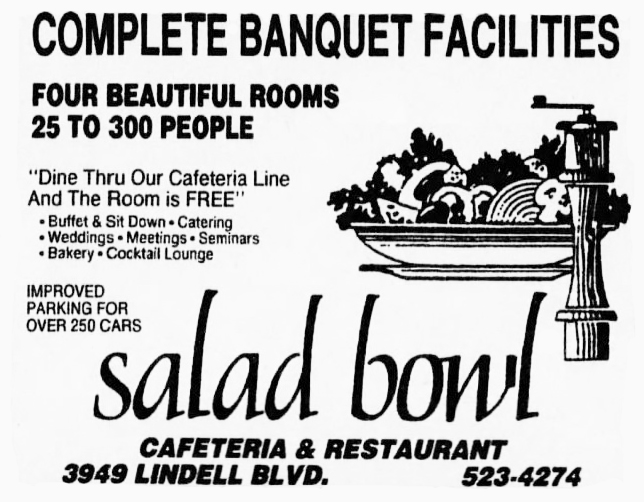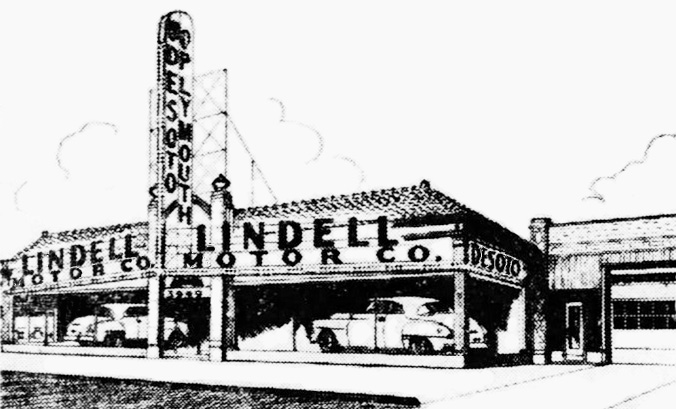The first Salad Bowl restaurant, at 4100 Lindell in St. Louis, was established in 1948 by two former employees of Miss Hulling’s Cafeteria downtown. The husband and wife owners were mainly concerned with making a living for their family and had little idea that, like Miss Hulling’s, their venture was destined to become a celebrated local institution and landmark. [above: final and primary location, 1989]
The Salad Bowl’s founders were Elmer and Anna Sewing, whose three sons would one day take over the cafeteria, having gained plenty of hands-on experience working there in their younger years. At its final location at 3949 Lindell Blvd. the sons, David and his twin brothers Norman and Norbert, took full charge after their father’s death in 1976. Knowing they had to expand the business, they encouraged greater use of the banquet rooms. To draw customers during the day the sons made the rooms available for free to clubs and organizations for meetings and talks if their members and attendees went through the cafeteria line. [Norbert and Norman Sewing at the bakery counter, 1989]
The cafeteria was located about halfway between two universities, making it possible for the cafeteria’s banquet rooms to become popular sites for talks and lecture series by professors. The Salad Bowl had the unique distinction of being the only eating place that I know of that advertised “seminars” among its attractions. [1988 advertisement] A few of the topics covered over time were homelessness, children’s mental health, the working poor, the global economy, and the Jewish sanctuary movement.
News conferences took place regularly at the Salad Bowl. In 1986 a speaker from Ralph Nader’s Public Citizen group discussed the rapidly rising rates of liability insurance, blaming it on greed in the insurance industry. The event was sponsored by the Missouri Public Interest Research Group and the Missouri Citizen-Labor Coalition.
Although, like many restaurant owners, Elmer Sewing had turned away Black diners at a time when he judged that white customers would not accept them, he often said that he was opposed to segregation. According to his grandson Stephen, who privately published a memoir-style history of the Salad Bowl* after its closure in December of 2005 [title page above], his grandfather was personally opposed to segregated eating facilities. He was said to be eager to welcome Black customers once the Civil Rights Act had passed, making it illegal to refuse service to patrons based on race. Stephen wrote that the cafeteria was one of the first in St. Louis to integrate.
Black organizations, clubs, and events by Black activists were included in the Salad Bowl mix, as were prayer breakfasts in honor of Martin Luther King. Another example was a news conference held by well known activist Ivory Perry who denounced President Ronald Reagan’s introduction of housing vouchers in 1982, calling it a step in federal abandonment of public housing and urging people to join a protest rally in Washington. A St. Louis section of the National Council of Negro Women held its 5th annual awards dinner there in 1986.
Both Black and white politicians gave talks at the cafeteria, and Jessie Jackson visited there. According to Stephen Sewing’s book, “Every state senator, state representative and governor has known the Salad Bowl because of all the political parties, press conferences, meetings and rallies held at the Salad Bowl over the years.” Organizations holding regular meetings included the Book Lovers Club, the League of Women Voters, the Press Club, Retail Druggists, Weight Watchers, the Worker’s Rights Board, the Women’s Coalition for the Democratic Party, and locals of the St. Louis Teachers Union and the Service Employees Union.
Scrolling through the notices of talks and public events held at the cafeteria made me realize how impossible it is to give more than a partial idea of how many and varied they were.
In the 1990s the cafeteria was also used as a site for flu shots, blood pressure tests, and school children’s immunizations.
The Salad Bowl menu focused on standard cafeteria comfort food such as Kidney Bean Salad, Whiting, Beef Brisket, Banana Cream Pie, and the St. Louis specialties, German Potato Salad and Toasted Ravioli. Customers could also stop at the bakery counter to buy baked goods to take home. A tavern room called Bits and Saddles operated for ten years as part of the complex and there was an underground parking garage, a remnant of the car dealership that had occupied the site before the Salad Bowl took it over. [shown below, 1952]
The restaurant also served as a special gathering spot for the extended Sewing family who used banquet rooms for their own wedding dinners and receptions as well as major holiday feasts. With the three fathers working long days, sometimes six days a week, often the only way to see them was for their families to come to dinner at the cafeteria. Their wives and children also put in time as spare hands for serving banquets, helping with bookkeeping, and other chores.
Now, when restaurants tend to be ranked and rated mainly for the quality and novelty of their cuisine and interior appointments, I find it refreshing to review a restaurant from the past that was so deeply a part of city life, and valued for that by thousands of St. Louisans.
© Jan Whitaker, 2022
- Two copies of the 90-page booklet are available at the main St. Louis Public Library.

















 It's great to hear from readers and I take time to answer queries. I can't always find what you are looking for, but I do appreciate getting thank yous no matter what the outcome.
It's great to hear from readers and I take time to answer queries. I can't always find what you are looking for, but I do appreciate getting thank yous no matter what the outcome.


